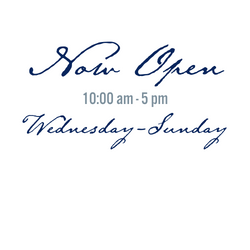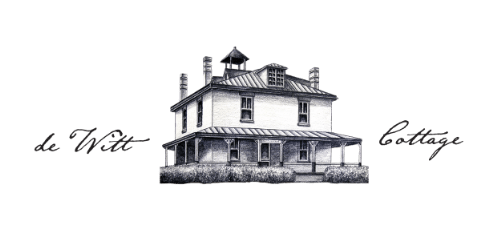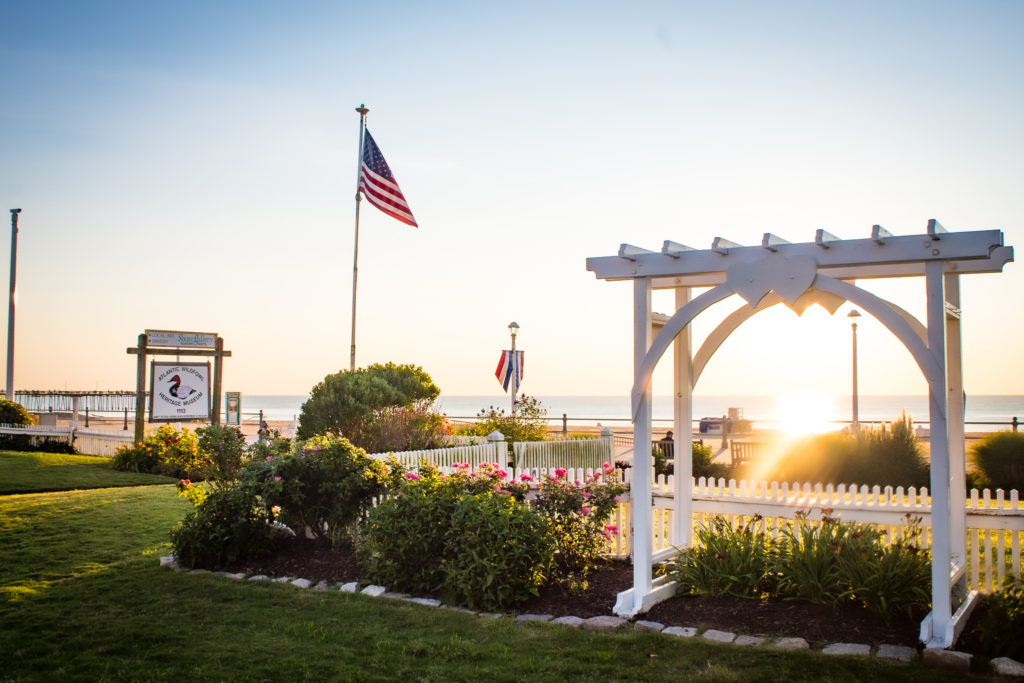125 Years of…
Love
Bernard Peabody Holland was a clerk for the Norfolk Southern railroad and worked as a clerk at the Princess Anne Hotel. He met Emily Randall Gregory when she stayed at the hotel during a layover when traveling from New York to Florida.
It was love at first sight. Her parents were resistant to the engagement, thinking that Emily could do better. After a three-year courtship, the family relented, and they were married. It is believed that Bernard used Emily’s dowry to purchase the oceanfront property from the Norfolk Southern railway for a sum of $8,000.
Emily’s father was very wealthy. He was a textile manufacturer who secured his fortune making uniforms during the Civil War. Bernard built The Cottage in 1895 as a wedding gift for his bride, Emily. They lived in the home for several years and their first child, Walton, was born on the premises.
Strength
Speaking to its structural integrity, the Cottage was built with fourteen-inch-thick brick walls, twenty-two rooms, a basement and an attic. The Cottage is a typical early beach house design. This was the only brick cottage on the Virginia Beach oceanfront, and thus earned the nickname, The Brick House. The Cottage is listed on the City of Virginia Beach, Commonwealth of Virginia and National Registers of Historic Places.
To speak to strength of family, the de Witt family, faced with the untimely death of their father in 1913 and then their mother in 1923, the oldest siblings, Elizabeth and Julia, assumed the chores of parenting for their 8 younger siblings. They succeeded in keeping their house as the nucleus for happy family life for over 65 years.
In 1929 at the onset of the Great Depression Julia, Harriet and Katrine began operating the cottage as a guest house to generate additional income. Boarders, who were frequently friends or acquaintances of the de Witts, were accepted on a limited basis and in the early years typically paid $7.50 a week or $1.50 a day for room and board. The de Witt Cottage became a popular place to stay and remained so until the 1970” s.
Heritage
Caroline, Julia, Harriet and Katrine de Witt, the last remaining sisters decided to sell their beloved Cottage in the mid 1980s during a slumping real estate market and a dip in Virginia Beach tourism. This resulted in only offers from real estate developers. The Sisters wanted their childhood beachfront home to be preserved. They were adamant that the Cottage be maintained. In 1988, they with their attorney Fred Kochey, structured a deal with the City of Virginia Beach, along with the Virginia Beach Historical Society, Virginia Beach Foundation, and the Back Bay Wildfowl Guild to insure the Cottage would remain a landmark on the hotel lined oceanfront. The City would take ownership of the property in exchange for an annual stipend to the de Witt sisters of $87,500. The City agreed to pay the money until the last de Witt sister passed away. With all four of the de Witt sisters in the 80s the City felt like that had a bargain. The stipend ended in December 2007 when Caroline, the last de Witt sister, passed away. The story does not end there. The Sisters were extremely savvy. They also stipulated that the Cottage had to be maintained in perpetuity. The Cottage can never be demolished, and the land developed. The Cottage must be maintained as a resort area cultural and education center.
Family
The Cottage has always been filled with family. In 1909 it was sold to Cornelius, a banker and cotton broker, and Cecille de Witt. With their 7 children, they departed the cobblestone streets of Norfolk for the ocean air of newly incorporated Virginia Beach. It was the understanding that this would be a summer home, but Cecille quickly fell in love with the property and refused to move back to Norfolk after the Summer season. Thus, making Cornelius and the children take daily train rides to Norfolk for work and school. Cornelius also purchased a block of land across the street (property formally occupied by the Raven Restaurant). There he kept 200 chickens and 2 cows, several horses and a mule, rabbit hutches, vegetable gardens, and wood piles.
3 children were born in the parlor of the house, which is currently our Gift Shop. Many relatives came to spend their summer vacation at the Cottage, enjoying the large wrap around balcony porch, cool ocean breees, a swing and rocking chairs.
Community
The Hollands were instrumental in the development of the Virginia Beach oceanfront. Bernard operated the local hardware store. In 1909, he with a group of businessmen, filed with the State of Virginia to incorporate the town of Virginia Beach. Bernard was also the Mayor of the City of Virginia Beach, twice – 1909 and 1914. Emily operated the first lending library in Bernard’s hardware store. The library later expanded to the first free standing library operated by Emily Johns whose husband operated Johns Brothers Heating and Cooling. That library building now stands on the grounds of the de Witt Cottage. Emily also operated the dry goods section of the hardware store. She was quite the salesperson.
The de Witt family also contributed to the growing Virginia Beach community. All of the siblings were educated with most graduating from college. Julia, Katrine, Harriet, and Caroline all became teachers. Cornelius Jr., John, Paul and Peter volunteered for World War II. Cornelius, Paul and Peter also participated in the beach life guard service, with Peter being one of the first judges of the East Coast Surfing Championship. Many Virginia Beach schools, gardens, churches, and libraries have been influenced by a member of the de Witt family.
Wildfowling & Decoys
Bernard Peabody Holland was an avid duck hunter. He used the open cupola on the roof as an observatory for wildfowl on the lakes behind his house. Very few are aware that wildfowling was the first form of economic tourism for Virginia Beach, and the economic engine that saved the town. Farmers who were unable to plant and harvest in the winter looked for ways to support their families. They quickly learned that hunting wildfowl and shipping the meat to points North, created cash flow for them to support their families in the winter. This led to the development of marketing hunting. At the time, wooden decoys were used by market hunters to attract waterfowl birds for hunting. The farmers became so efficient with the hunting that they almost sent ducks to extinction. In 1914, the Federal Government stepped in with the Migratory Bird Act and made market hunting illegal. The wood decoys were of no real value until the 1960s when they became an accepted form of folk art and very collectible.
In February 1991, the Back Bay Wildfowl Guild won City Council approval to occupy the de Witt Cottage after renovation of the historic landmark was completed. In September 1995, the Atlantic Wildfowl Heritage Museum opened. Many of the antique decoys used by the early market hunters are sold for hundreds of thousands of dollars and displayed in the museum exhibits. The Museum also hosts the largest exhibit of Virginia Beach memorabilia and old Virginia Beach video.
In final, the de Witt sisters’ wish was achieved, and their beloved Cottage has been operating as a cultural and education center for the visitors and citizens of Virginia Beach for the past 25 years.
Take a Tour of Our Grounds
The Historic de Witt Cottage is located on the Virginia Beach Boardwalk and has captivating views of the Atlantic Ocean.




